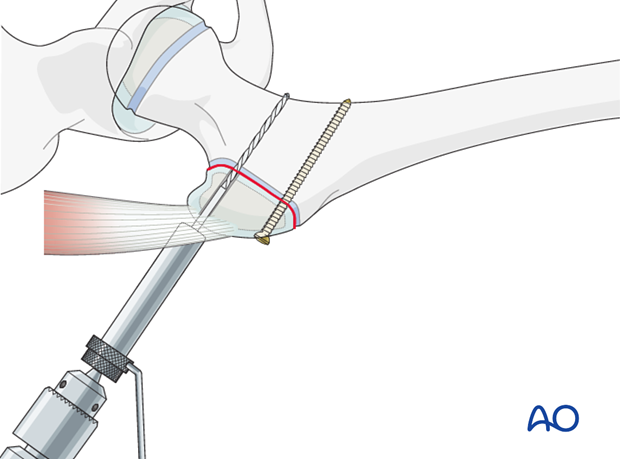Open reduction, screw fixation (greater trochanter)
1. Preliminary remarks
Introduction
An avulsion of the greater trochanter, with disruption of the abductor mechanism can be repaired by open reduction and screw or tension band fixation depending on the size of the avulsed fragment.
It is essential to ensure that the bony fragment is sufficiently large or it may split when screws are inserted. A tension band wire technique is a good alternative for smaller fragments.
For children with 4 or more years of growth remaining, removing the screws should be considered.

Equipment selection
The following implants are required:
- 3.5, or 4.5 mm cortex screws
The choice of implant depends on the age and size of the child.
Washers are optional depending on the bone quality and fracture configuration.

2. Patient preparation and approach
Patient preparation
This procedure is normally performed with the patient in a lateral position.

Approach
The fracture fragment is approached with a lateral approach, the hematoma is evacuated and periosteum is cleared to allow accurate reduction of the fragment(s).

3. Reduction
The trochanteric fragment is directly reduced to its bed and the position confirmed using image intensification. A towel clip may be used for temporary control, or a K-wire can be used to aid manipulation and to provide temporary fixation.

4. Fixation
Guide wire insertion
The first K-wire is placed in the center of the proximal part of the greater trochanter.
There are several surgical options that depend on the available implants and the surgeon’s experience.

Cortex screw fixation
The initial K-wire holds the trochanteric fragment in place.
A 2.5 or 3.2 mm drill is used to make a drill hole in the distal part of the greater trochanter, perforating the cortex on the calcar side.
The screw length is measured.

A 3.5 or 4.5 mm self-tapping cortex screw is inserted and tightened.

The K-wire is removed and a second drill hole is made at the site of insertion.
The screw length is measured.

A 3.5 or 4.5 mm self-tapping cortex screw is inserted and tightened.

Closure
Routine closure according to the surgeon's preference.
5. Aftercare
Introduction
Range-of-movement exercises should start in the immediate postoperative period to prevent stiffness. Surgeons should indicate if any extremes of movement should be avoided.
Forces through the hip are less with toe-touch weight bearing than with non-weight bearing.
Crutch walking with toe-touch weight bearing should therefore be advised for 3–4 weeks.
This needs to be taught to children and supervised by a physiotherapist.
Abductor strengthening exercises can be started after 6–8 weeks if there are clinical and radiological signs of healing.

Infection
See the additional material on postoperative infection.
Weight bearing
Having started with toe-touch weight bearing, children progress to partial weight bearing and then to full weight bearing according to their age and the predicted rate of healing of their fracture.
Even older adolescents should be fully weight bearing without aids at three months.
Sports
Swimming can be allowed as soon as partial weight bearing is permitted.
Contact sports should be avoided for at least six months.
Follow-up x-rays
X-rays are generally taken immediately after the surgery and at 6 and 12 weeks.
Implant removal
The fracture should be healed and consolidated prior to implant removal (see Healing times).
Implants in young children should always be removed to prevent them from being covered by bony overgrowth.
Implant removal is not compulsory in adolescents.













